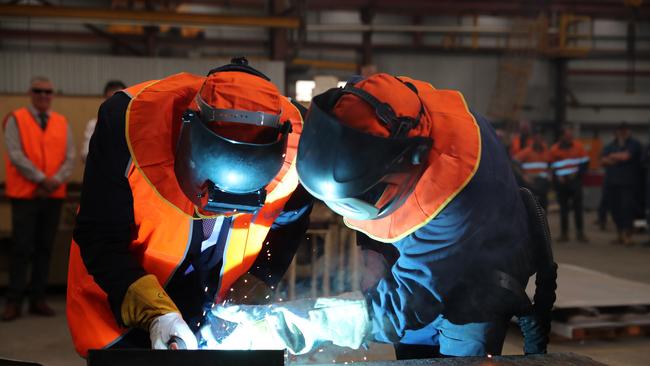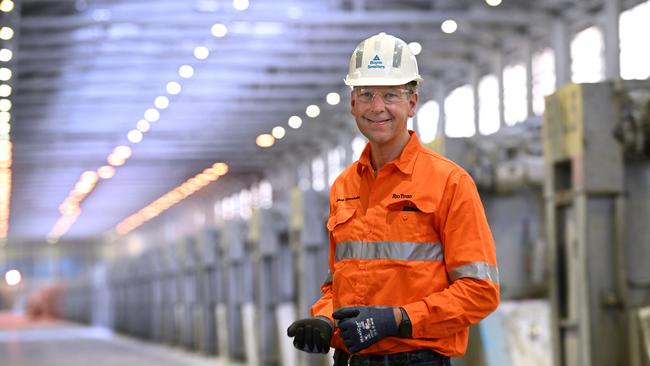Power price hit threatens Tomago aluminium smelter: Rio Tinto
Tomago’s owners, including Rio Tinto and CSR, could pay twice as much for their electricity needs once a coal contract ends in 2028.

The giant Tomago aluminium smelter near Newcastle faces the threat of closure in 2029 with a planned move to a new energy contract costing double the current coal-based power contract, raising fears over the future of more than 1000 workers at the site.
Rio Tinto chief executive Jakob Stausholm confirmed that a plan to move the electricity contract from the current coal contract by the end of 2028 would see Tomago’s owners pay twice as much for their electricity needs.
A decision is due this year on how to move forward with the smelter given the power cost crunch.
“I can’t give you an assurance on Tomago today,” Mr Stausholm told The Australian. “If you can’t get competitively priced electricity, you cannot have smelting.”
The NSW aluminium smelter is the single largest user of energy in the state, and its current power contract with AGL Energy expires in late 2028. Rio owns a 51 per cent stake in the Tomago joint venture along with CSR and Hydro Aluminium.
The smelter needs 3 to 4 gigawatts of renewables to meet its 950 megawatt needs, plus back-up options given the variability of wind and solar supplies. Sources said insufficient supplies of green power would be available once the current deal expires in 2028. That would mean paying over the odds for higher coal-based pricing as an interim solution until green power was available from 2032-33.
That level of pricing “doesn’t work”, Mr Stausholm added.
Finding competitively priced coal from 2029 until extra firmed renewables became available across NSW in 2033 was also problematic.
Tomago currently relies heavily on AGL’s coal-fired Bayswater power station, which is set to close between 2030 and 2033.
“The problem we are facing with a place like Tomago right now is it might take a longer time to get renewables and the electricity from coal-fired power that we’ve been quoted is extremely expensive,” Mr Stausholm added.

The Rio boss made the comments after its annual profit dipped 8 per cent to $US10.9bn due to weaker iron ore prices. The miner declaring a smaller final dividend as it flagged a production hit from a series of cyclones in the Pilbara.
The 2024 full-year result missed analysts’ consensus of $US11bn with the price of iron ore, which continues to dominate its earnings, falling 11 per cent over the period amid choppy Chinese demand.
Rio will pay a $US2.25 a share final dividend, down 13 per cent on the $US2.58 payment a year earlier. Rio shares fell 1.5 per cent, or $1.86, to $120.09 on Thursday.
The global mining giant booked underlying EBITDA of $US23.3bn, a decline of 3 per cent compared to 2023, on revenue of $US53.7bn, off 1 per cent.
Rio’s total dividend payout for 2024 was $US4.02 – 8 per cent beneath the $US4.35 paid for its 2023 results.
The producer’s annual net profit rose 15 per cent to $US11.5bn, reflecting a series of asset sales and lower impairment charges from its alumina refineries in Queensland.
The Rio boss was quizzed by investors on its appetite for mergers and acquisitions after it emerged in January that Rio and its rival Glencore held early-stage talks about a merger deal valued in the order of $260bn that would be the biggest ever in mining.
One of the potential hurdles to a deal was Glencore’s large exposure to coal, including multiple mines in Queensland and NSW, and seen as a major roadblock given Rio has exited the coal industry.
However, Glencore, which reported results on Wednesday, said the fossil fuel did not need to be an impediment to any deal with a rival.
“Coal is not the four-letter word it was,” Glencore chief executive Gary Nagle said on a call with analysts, noting Glencore investors such as Blackrock and Vanguard Group were also major shareholders in its competitors including Rio.
“If they’re happy for Glencore to keep coal, then surely if one of our peers wants to merge, buy, combine with us, if they’re happy with it in Glencore, they’d be happy with it in one of our competitors,” Mr Nagle noted.
One analyst on the investor call said the Glencore approach appeared to have been taken quite seriously by Rio’s board, asking Mr Stausholm if that meant the miner could go back into coal.
“I don’t know where you heard this thing about the board. I cannot comment on rumours and it’s entirely a rumour. But you’re right in that we left coal just before I joined the company in 2018, and we have no plans for going into coal again.”
Mr Stausholm said he was also cautious on US President Donald Trump’s move to impose 25 per cent tariffs on all steel and aluminium imports but remains upbeat about investing in the US and Canada.
“The economic impact on tariffs to Rio Tinto might be both pluses and minuses, and we don’t know whether the net will be positive or negative,” Mr Stausholm told analysts after releasing its annual results.
“It really depends on how the tariff hits. If all countries are getting a tariff, the impact for us is zero. The problem is if it is only one country and the country we are selling into, but then of course we could redirect our aluminium into other markets and other producers will supply the US market.”
Speaking from Washington, Mr Stausholm said he remained positive on the prospects for its Resolution copper deposit in Arizona, one of the world’s largest undeveloped copper reserves.
“Right now I am sitting in the US, and we are very keen to invest in the US. We have Resolution, which could produce 25 per cent of the copper needs of the US. We are also one of only two that has a copper smelter, and it’s been difficult to make money on copper smelting in the US, and maybe there will be better conditions for that in the future. I’m also very keen on investing in Canada.”
Rio said it had generated $US15.6bn in net cash from its operations, 3 per cent higher than in 2024 while Rio’s Pilbara operations saw underlying EBITDA drop 19 per cent to $US16.2bn.
The steelmaking commodity continued to do the heavy lifting with shipments of 328.6 million tonnes of iron ore from its Pilbara ports in 2024, in line with production guidance of 323 to 338 million tonnes, which remains unchanged for 2025 despite its recent setbacks.
Disruption from a series of cyclones in WA has meant Rio’s port operations have been out of action for almost two weeks since late January, with the miner conceding first-quarter shipments will be affected by the impact of torrential weather and rain.
Rio said the total losses from all four cyclones are anticipated to be around 13 million tonnes.
“We have mitigation plans in place to offset around half of this over the course of the year. The system has limited ability to mitigate further losses from weather if incurred,” Rio noted.
Rio expects the near-$11bn takeover deal for Arcadium Lithium – listed in New York and on the ASX – to close in March.
It’s betting big on lithium in contrast to mining peers like BHP and Glencore who have opted to steer clear of investment in the battery ingredient.
In December, the Rio board approved spending $US2.5bn ($3.93bn) to expand the Rincon project in Argentina, its first commercial-scale lithium operation.
The profit fall follows a major investor reshaping of Rhodes Ridge, Rio’s leading undeveloped iron ore deposit in the Pilbara, which is set to start production in 2030.
Mitsui paid $8.4bn for a 40 per cent stake in the project, adding to the fortunes of two of WA’s wealthiest families in reclusive billionaire Angela Bennett and the Wright family.


To join the conversation, please log in. Don't have an account? Register
Join the conversation, you are commenting as Logout